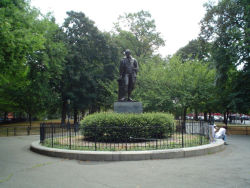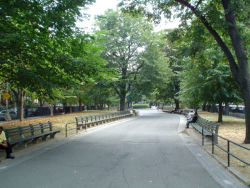Fulton Park
Fulton Park
What was here before?
This site was first inhabited by the Lenape. It later bridged the properties owned by Sarah Lefferts and Moses Suydam (both from prosperous farming families) in the early 19th century. By 1880, the triangular block between Lewis and Stuyvesant Avenues was lined with stores and what were described as “ramshackle buildings.”
How did this site become a park?
At the request of Brooklyn Borough President J.E. Swanstrom, the City resolved to set aside land for a public park along Fulton Street in 1902. Two years later the City of New York acquired the land by condemnation and improvements to the park were still underway when the public restroom (still in use), designed by the well-known firm of Helmle and Huberty opened in 1910.
In 1930, a statue depicting Robert Fulton and the Nassau, the first steam ferry, was erected in the park and dedicated by the Society of Old Brooklynites. Created in 1872 by Bohemian artist Caspar Buberl, this statue formerly stood in a niche in the Fulton Ferry House on the Brooklyn waterfront. The statue was restored in 1935, and the corroded zinc original was replaced by a bronze replica in 1955.
In 1997-98, Fulton Park underwent reconstruction. Today, visitors can walk through an ornamental garden along Lewis Avenue or take the central meandering pathway through the park’s mature trees towards the historic public restroom. The park provides an organic transition between the commercial avenue to its south and the residential buildings flanking the opposite side.
Who is this park named for?
A brilliant painter, engineer, and inventor, Robert Fulton (1765-1815) is best known for launching the first commercially successful steamboat. He was born in New Britain, Pennsylvania on November 14, 1765. In 1786, he moved to England to study painting under Benjamin West but grew more interested in engineering and naval warfare. While living in France between 1797 and 1806, Fulton built the submarine Nautilus (1800) and an experimental steam-powered vessel (1803).
With the financial support of U.S. Ambassador to France Robert Livingston, Fulton returned to the United States to develop a steam-powered vessel to travel the Hudson River. On August 9-10, 1807, Fulton’s steamboat made the trip from New York City to Albany in thirty-two hours, far faster than any sailing vessel could dependably travel. The steamboat was named the North River Steamboat of Clermont, later shortened to Clermont. Following its success, Fulton built a torpedo boat, a steam frigate used in the War of 1812, and the first steam ferry, the Nassau. Fulton died in New York City on February 24, 1815. Fulton Streets in Brooklyn and Manhattan, on opposite shores of the ferry service, were named in his memory.
Check out your park's Vital Signs
Clean & Safe
Green & Resilient
Empowered & Engaged Users
Share your feedback or learn more about how this park is part of a
Vital Park System


